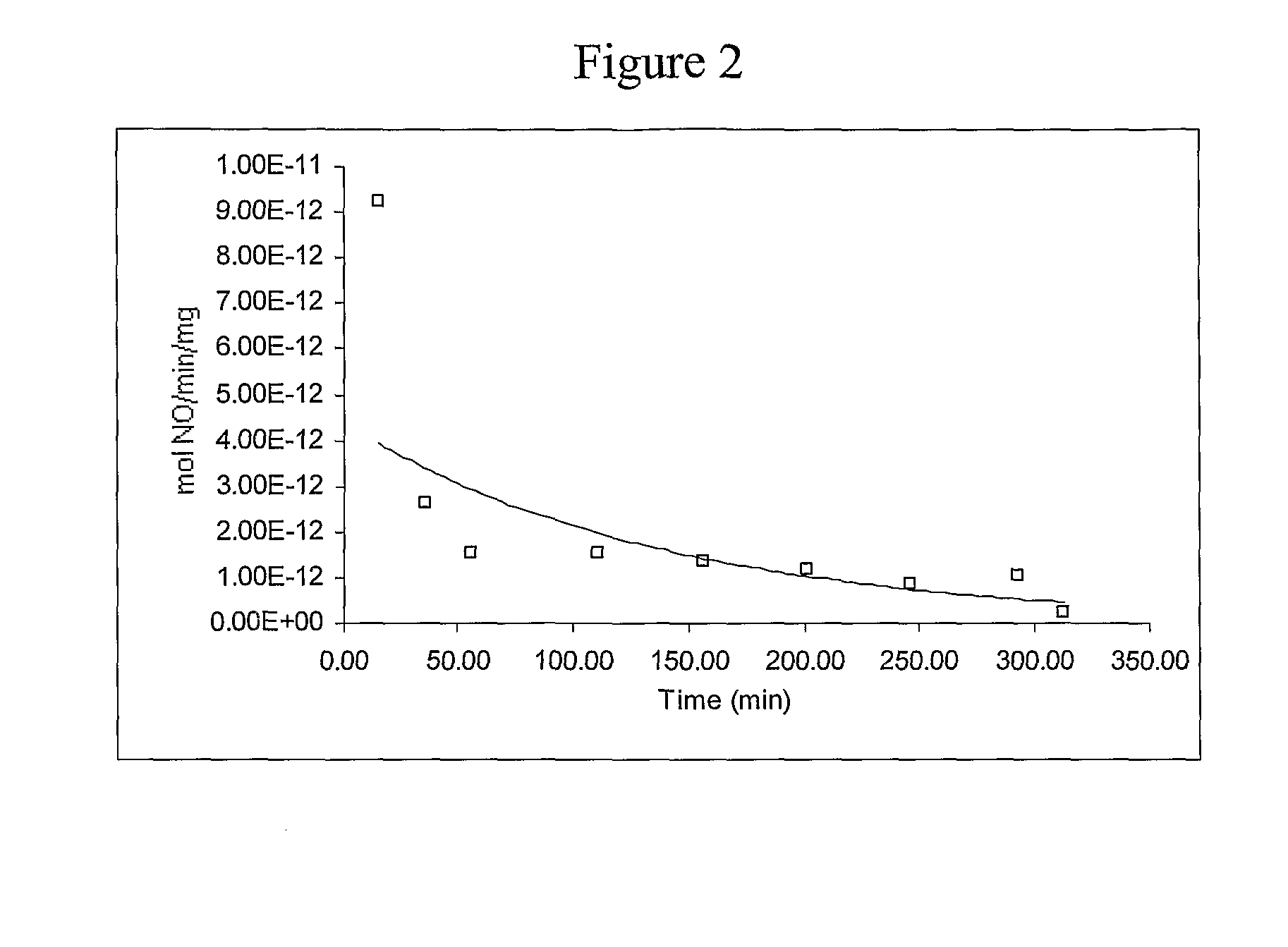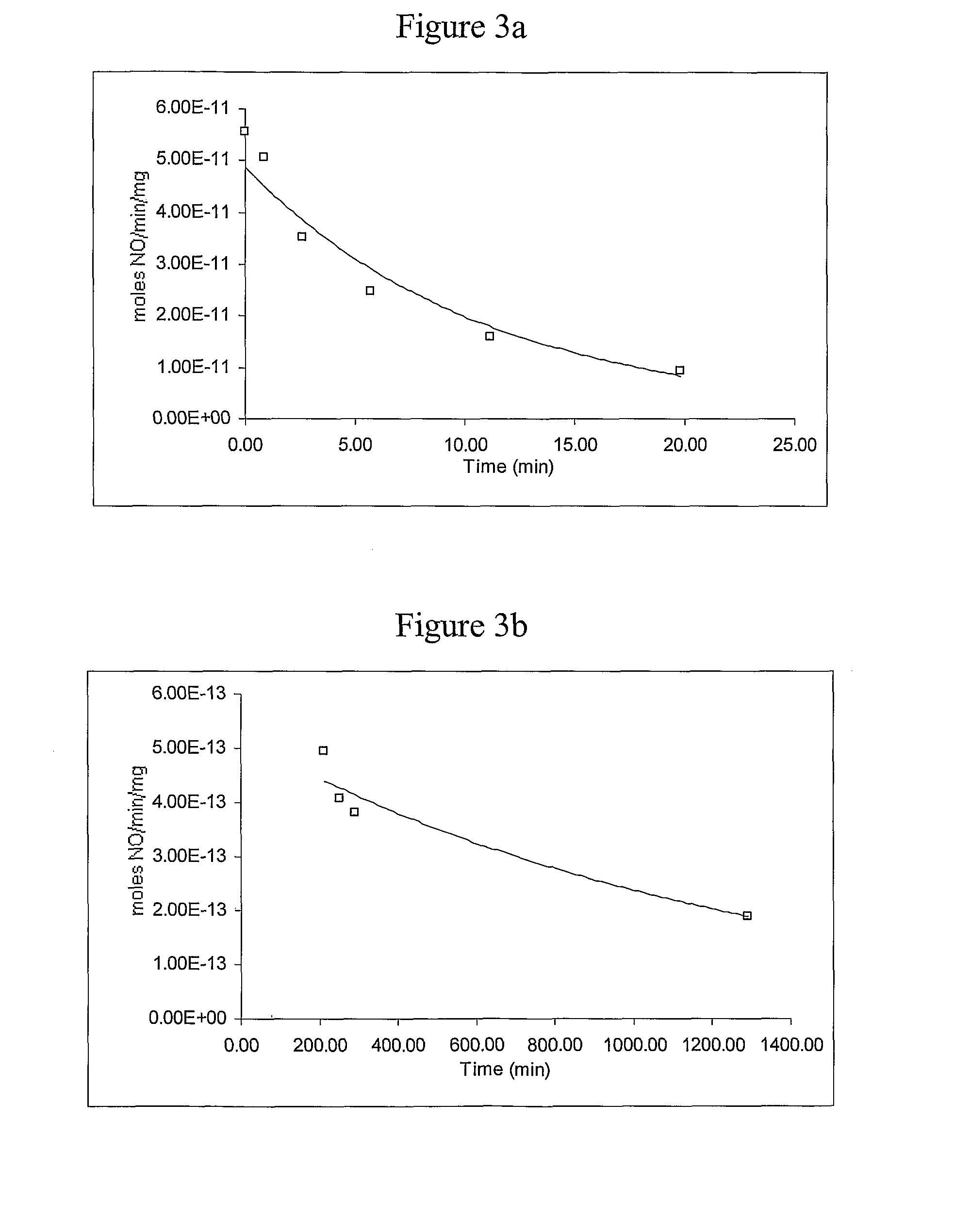Polysaccharide-derived nitric oxide-releasing carbon-bound diazeniumdiolates
a technology of carbon-bound diazeniumdiolates and polysaccharides, which is applied in the direction of biocide, drug composition, antibiotics, etc., can solve the problems of inability to exogenously administer gaseous nitric oxide, significant technical hurdles and safety concerns that must be overcome, and methods that have not proved clinically effective, etc., to achieve the effect of improving existing industrial processes
- Summary
- Abstract
- Description
- Claims
- Application Information
AI Technical Summary
Benefits of technology
Problems solved by technology
Method used
Image
Examples
example 1
[0066]This example describes a generalized method of preparing nitric oxide (NO)-releasing materials derived from monosaccharides, disaccharides, or polysaccharides.
[0067]A solution or slurry (as appropriate) of the desired monosaccharide, disaccharide, or polysaccharide or a suitable derivative thereof was prepared in a solution of sodium methoxide or other strong base in methanol contained in a Parr pressure bottle. Nitrogen, argon, or other inert gas was passed through the apparatus and bubbled through the solution for 5-10 min, the bottle was placed into the reactor system (see Hrabie et al., J. Org. Chem., 58, 1472 (1993)), further flushed with inert gas, and vented, and nitric oxide gas was admitted to a pressure of 5 atm. The reaction was stirred for ½-3 days at room temperature with the addition of NO as needed during the first day to maintain the reservoir pressure. Excess NO was then vented, and inert gas was bubbled through the resultant solution for 5 min. The product wa...
example 2
[0068]This example describes a method of preparing a NO-releasing cotton fabric.
[0069]A solution of sodium methoxide in methanol was prepared by adding 25 mL of a commercially-obtained 25% sodium methoxide in methanol solution (Sigma-Aldrich) to 200 mL of anhydrous methanol contained in a 500 mL glass Parr hydrogenation bottle. To this was added several square pieces of 100% cotton fabric having a total weight of about 2 g, and the resulting slurry was treated with NO for 40 h as described in Example 1. The cotton pieces were removed with tongs, washed several times with methanol, squeezed dry between absorbent paper towels, and placed in a vacuum desiccator overnight for complete drying. The resulting slightly off-white pieces still weighed about 2 g, and were slightly less soft when compared to the starting fabric
example 3
[0070]This example describes another method of preparing a NO-releasing cotton fabric.
[0071]A solution of 8.0 g of commercial sodium hydroxide pellets (0.2 mole) in 200 mL distilled water was prepared in a 500 mL glass Parr hydrogenation bottle. To this was added several square pieces of 100% cotton fabric having a total weight of about 0.66 g, and the resulting slurry was treated with NO for 23 h as described in Example 1. The cotton pieces were removed with tongs, washed several times with water, squeezed dry between absorbent paper towels, and placed in a vacuum desiccator overnight for complete drying. The resulting off-white pieces still weighed about 0.66 g, and were slightly less soft when compared to the starting fabric.
PUM
| Property | Measurement | Unit |
|---|---|---|
| pH | aaaaa | aaaaa |
| weight | aaaaa | aaaaa |
| weight | aaaaa | aaaaa |
Abstract
Description
Claims
Application Information
 Login to View More
Login to View More - R&D
- Intellectual Property
- Life Sciences
- Materials
- Tech Scout
- Unparalleled Data Quality
- Higher Quality Content
- 60% Fewer Hallucinations
Browse by: Latest US Patents, China's latest patents, Technical Efficacy Thesaurus, Application Domain, Technology Topic, Popular Technical Reports.
© 2025 PatSnap. All rights reserved.Legal|Privacy policy|Modern Slavery Act Transparency Statement|Sitemap|About US| Contact US: help@patsnap.com



